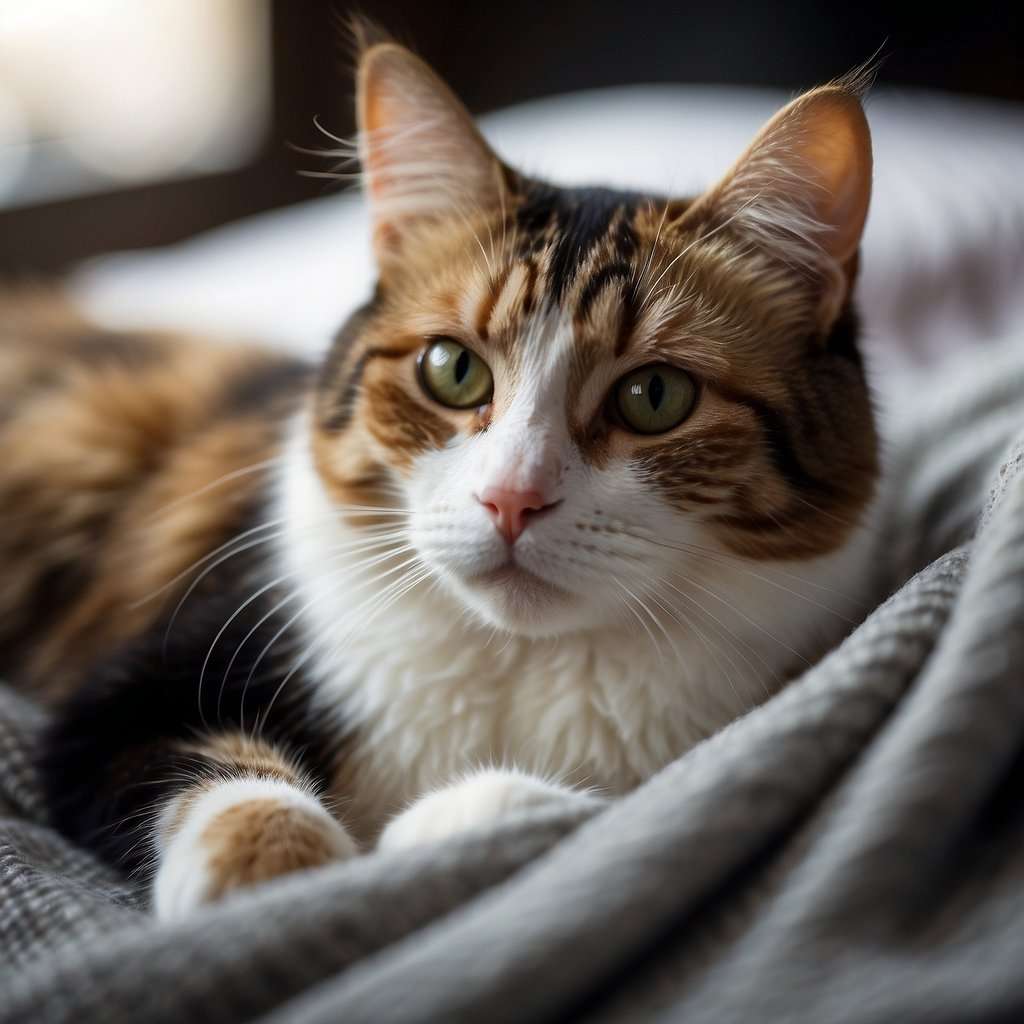Have you ever gazed at the mesmerizing patchwork of black, orange, and white on a calico cat and wondered if their unique appearance reflects an equally unique personality or condition, such as autism? (1)
It’s not unusual to associate distinctive traits with distinct behaviors, but when it comes to calico cats and autism, it’s important to sift through myths and misunderstandings.
Autism is a complex human neurological condition, and while it’s characterized by challenges in social interaction, repetitive behaviors, and communication, it’s not a framework that translates to our feline friends, even cat enthusiasts.
There is no scientific evidence to support a connection between calico coat color and autism in humans.
This myth likely stems from observations of individual cats and personal anecdotes, which lack the rigor of controlled research.
Attributing human conditions like autism to animal behavior can be misleading and disrespectful to both individuals with ASD and our feline companions.

Calicoes, like all cats, have their charming quirks and personalities.
Some of their behaviors might seem mysterious or unusual, but attributing human neurological conditions to cats would be like comparing apples and oranges.
The truth is, that calico cats are simply cats with a particular coat color pattern, dictated by genetics rather than cognitive conditions.
Their colorful fur is the result of a genetic trait known as “X-chromosome inactivation,” and it has no bearing on their cognitive abilities or mental health. (2)
However, delving into the social behavior of calico cats can provide insights into their interactions with humans and other animals, comparing their social patterns with other cat breeds.
Factors such as environment and past experiences can influence their social nature, making them unique and fascinating creatures to observe and understand.
So if you share your home with a calico, rest assured that their unique behaviors, such as scratching to keep their claws in shape, are a normal part of their feline nature, not a sign of an autism spectrum condition.
Key Takeaways
- Autism cannot be directly applied to cats, including calicos.
- Calico cats’ unique coat patterns result from genetics, not cognitive conditions.
- Feline behaviors that might seem unusual are typical for cats, not an indication of autism.
Understanding Are Calico Cats Autistic?

What Are Calico Cats? Simply put, calico cats boast a tri-color fur pattern, typically combining white with patches of orange and black.
This patchwork of colors isn’t random; it’s a direct result of genetics. Female cats have two X chromosomes, and the coloration of their fur is linked to these chromosomes.
In calicos, a phenomenon known as X-chromosome inactivation is at play. Each cell ‘turns off’ one X chromosome, allowing for different colors to emerge, resulting in the unique calico coat pattern.
Understanding this genetic process is important in debunking the myth that calico cats are autistic.
- Genetics of Calico Cats: The calico pattern arises due to genes located on the X chromosome.
- Female: 2 X chromosomes (XX)
- Male: 1 X and 1 Y chromosome (XY)
- X-Chromosome Inactivation: A random process that decides which X chromosome gets silenced in each cell, leading to varied fur patterns. (3)
Calico isn’t a breed, so you’ll spot these colors in various cat breeds, from the sturdy American Shorthair to the fluffy Maine Coon and the elegant Persian.
Now, tortoiseshell cats are often lumped together with calicos, but they’re like close cousins—torties mostly lack the white fur that’s classic in calicos.
Common Myths About Calico Cats Got a calico that’s a bit quirky? Some folks might jump to the conclusion that calico cats show signs similar to autism.
But remember, cats aren’t humans; they don’t experience the world as we do. Autism cannot be diagnosed in cats, including calicos, as it is a human neurodevelopmental condition.
In other words, calico cats are no more “autistic” than any other cats are. However, it is important to understand the unique personalities of calico cats and not rely on stereotypes or myths about their behavior.
Each calico cat is an individual with their own experiences and environment that shape their personality, and understanding this is crucial for their proper care.
Heard about the rare male calico cat? They exist but are quite the unicorns in the cat world.
Due to their unusual XXY chromosomal makeup, only about 0.03% of calico cats are male—that’s 1 in 3,000! And if you’re looking to purchase a fertile male calico (yes, most are sterile), prices can soar up to $2,000.
In short, calico cats are a vibrant splash of feline genetics in action. Cherish them for their uniqueness, and don’t get tangled up in the myths!
Behavioral Insights into Calico Cats

Common Behaviors:
- Communication: Your calico will often use a combination of vocal chirps and body language to chat with you. Is she trilling softly? That’s a friendly “hello”!
- Feisty Moments: Yes, calicos can be a little spitfire at times. This zest is just part of their charm!
- Repetitive Behaviors: Spot her chasing the same toy repeatedly. It’s normal! Cats love routines and familiar games. (4)
Personality Spectrum:
- Independent Streak: Calicos value their alone time. They aren’t aloof – just confident solo adventurers!
- Social Butterfly: Contrary to their love for independence, don’t be surprised if your calico seeks out your company for some cuddle sessions.
Decoding Actions:
- Playfulness: Toys scattered everywhere? It’s playtime! Calicos, like most cats, express their hunting instincts through play.
- Ear & Tail Talk: Ears pinned back or a swiftly moving tail? Your feline might be irritated. Best to give her some space.
Did you know a mere 0.03% of calico cats are male? That’s one in about 3,000! And if you stumble upon a fertile male calico, remember they can come with a hefty price tag, costing up to $2,000.
Now, let’s clear up a common question: Are calico cats autistic?
The short answer is no. While they may display unique behaviors and have diverse personality traits, these are part of the normal variations within the species.
It’s the intricate dance of genetics that paints their stunning coats and not a link to cognitive or social traits typically associated with human conditions like autism.
However, understanding cat behavior, especially in calico cats, can give us unique ways to communicate and bond with our feline companions.
Calico cats are a colorful blend of personality types. Some days you’ll get the independent thinker, and other times, a social kitty craving your attention. Remember, every twitch, stretch, and meow is a step into understanding your fabulous calico.
Enhancing Your Relationship with Your Calico Cat

Calico cats are unique, not just for their beautiful tricolor coats, but also for the distinctive companionship they offer you. Have you ever wondered how you might strengthen that bond? Well, you’re in luck!
Building a Stronger Bond
Every moment spent caring for your furry friend helps deepen your connection. Remember, calico cats, like all felines, thrive on a balance of love and routine. (5)
Avoiding Stressors for Your Cat
A stressed-out cat can develop health issues. So, what’s the secret to a relaxed kitty? Familiarity and quiet time! Avoid sudden changes and loud noises around your calico to keep her purring constantly.
- Activities to Strengthen Your Connection
- Playtime: Use toys to mimic hunting behaviors.
- Grooming: Brush your calico regularly; it’s a bonding ritual.
- Talking: Yes, talk to your cat! They often appreciate the sound of your voice.
Dos and Don’ts in Daily Interaction
| Do | Don’t |
| Do offer consistent meal times. | Don’t overfeed; obesity is a health risk. |
| Do maintain a clean litter box. | Don’t ignore any signs of medical issues. |
| Do provide scratching posts. | Don’t scold harshly; patience is key. |
Male calico cats are rare, often sterile, and can have health issues related to Klinefelter syndrome. Whether male or female, calico cats typically live 12-20 years.
Your attentiveness to diet, health, and medical care plays a big role in your cat’s longevity.
Correcting Behaviors with Love and Patience
Did you know? Correcting your calico’s mishaps with gentle guidance reinforces good habits without damaging your bond. Calico cats are sensitive creatures, and a patient approach is your best tool.
There you have it – practical, easy ways to ensure that your calico cat shares a long, happy, and healthy life by your side. Don’t let those big, expressive eyes trick you: It’s your daily loving care that keeps them thriving!
The Quirky World of Living with Calico Cats

Let’s dive into some playful insights and practical tips about your colorful feline.
Environmental Enrichment: For your indoor cat, the world is inside four walls. To keep those vibrant calico brains engaged:
- Toys: Keep a variety of toys around to cater to their playful side.
- Puzzles: Food puzzles can provide mental stimulation and a bit of exercise. (6)
Vertical Retreats: Cats love heights (yours isn’t just being lofty and superior for the fun of it). Shelves or cat trees can be a calico’s castle in the clouds, offering:
- Quiet space
- A vantage point to observe their domain
- A sense of security
It’s a reign of peaceful oversight in the living room kingdom!
Spaying and Neutering are not just for population control. They are your ticket to ensuring your buddy’s health and tempering those calico capers.
Plus, you’ll sidestep the “miracle of life” turning into the “how did we end up with five more cats?”
Psychological Stimulation: It’s not all catnip and yarn. Calicos are famous for their strong personalities. To keep your cat’s environment engaging, consider:
- Change up their surroundings occasionally with new sleeping spots or lookout points.
- Interactive playtime – laser pointers, anyone?
Remember, quirky doesn’t mean complicated. A simple cardboard box can turn into a day of adventure for your calico crusader!
The Life with a Calico is a tapestry woven with bold colors and surprising patterns, much like the cats themselves.
Embrace the quirky, cherish the uniqueness, and enjoy the loving chaos that is calico cat ownership. Your calico’s antics? A daily dose of laughter. The stories you’ll have? Endless!
Promoting Health and Well-being

Mental health in cats can be optimized by ensuring a nurturing environment and appropriate care.
Mental and Physical Health of Your Calico Cat
Your calico cat thrives when both their mental stimulation and physical health are attended to. This includes:
- Routine veterinary check-ups.
- A balanced diet.
- Regular exercise (think fun with a laser pointer or catnip toys!). (7)
Impact of Environment and Care on Well-being
The environment you create for your cat can profoundly affect their well-being. Here are a few tips to make your home a cat paradise:
- Offer various perches and hideaways.
- Keep a clean litter box which encourages good hygiene.
- Consistency is key. Maintain a stable routine to avoid stress.
Creating a Stimulating Home Environment
Did you know a stimulating home environment can keep your cat physically fit and mentally sharp? Try incorporating:
- Interactive feeders to encourage problem-solving.
- Toys that mimic prey, like feathers or mice, to stimulate their natural hunting instincts.
Remember, each cat is an individual with its own preferences and personality.
There’s no one-size-fits-all approach, but with love and attention to their needs, you’re on the right path to promote a healthy life for your calico friend.
Quick Recap

There’s a deeper neurological condition like autism at play, given how humans experience it. But let’s clear the air:
- Human vs. Feline Brains: Your calico cat’s brain is wired quite differently from yours. So, while they may seem mysterious at times, calico cats do not experience autism in the way humans do.
- Unique Coloring and Genetics: That fabulous splash of orange, black, and white isn’t just for looks. It comes from specific genetic patterns and X-chromosome inactivation, which have zero links to the cognitive and social traits associated with autism.
- Behavioral Diversity: From frolicking about to being loners, calico cats show a range of behaviors that are normal for their species. These behaviors are just part of their charm, not indicators of autism.
And if you’re hunting for that rare male calico, remember, they’re like finding a four-leaf clover; about a 0.03% chance in the calico population.
But hold onto your wallets, as a fertile male could set you back up to $2,000.
So next time your calico does something that makes you go “hmm,” just remember—it’s all part of their calico charisma.
No need to worry about them being on the spectrum; they’re simply expressing their unique feline selves through their cat’s behavior. Keep on enjoying the enigma wrapped in a patchwork fur coat – your calico cat!
Frequently Asked Questions

Let’s clear up some confusion and get to the heart of your most pressing queries on whether these colorful kitties might be autistic and other fascinating calico cat wonders.
Can cats, particularly calico cats, be autistic?
No evidence suggests that cats, calico or otherwise, experience autism the same way humans do.
Though you might notice some behaviors in your feline friend that echo autistic traits in humans, remember that cats’ cognitive processes differ vastly from ours.
Why do people think calico cats might be autistic?
It’s likely because some cats exhibit behaviors reminiscent of those on the autism spectrum, such as challenges in social situations or adherence to routines.
However, this is a mere resemblance and not an indication of autism in calico cats.
Are all calico cats female, and does gender affect behavior?
Indeed, nearly all calico cats are female due to the genetic quirk that determines their unique coloring.
However, male calicos do exist, although they are rare and often sterile due to a genetic anomaly called Klinefelter Syndrome.
This syndrome allows male cats to display both orange and black colors, making up about 1 in 3,000 calico cats.
Gender may play a role in certain behaviors, but the personality of calico cats is not dictated by their gender.
It is important to take all cats, regardless of gender, to the veterinarian for yearly check-ups and routine preventive care to ensure their overall health and well-being.
How can I interpret my calico cat’s behavior more accurately?
Observe your cat’s behavior patterns and consider factors like environment, health, and socialization to understand them better. If you’re ever puzzled, a vet or a feline behavior specialist could offer insights for a clearer perspective.
What are some unique personality traits of calico cats?
Calico cats don’t have a specific set of personality traits tied to their coat color. Like any cat, their personalities can range from aloof and independent to playful and affectionate. They are individuals just like we are!
How can I improve my relationship with my calico cat?
Spend quality time with them, respect their need for personal space, and provide enriching activities. Understanding your calico’s unique personality and needs goes a long way in nurturing a loving bond.


